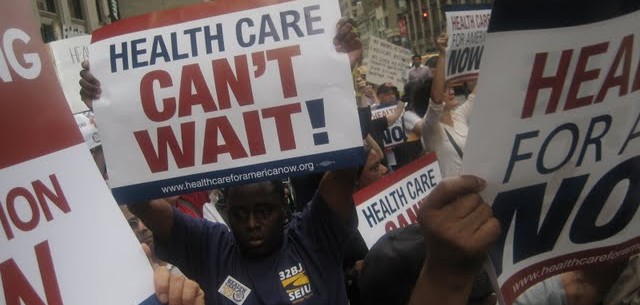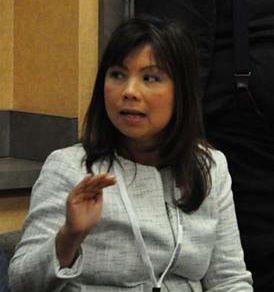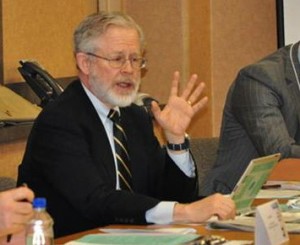Following up on its successful Union Healthcare Summit in late February (see post of February 26, 2014 below), Labor Press convened a follow-up meeting to further dig into the two major topics that emerged at the first event: provisions of the Affordable Care Act (ACA) that threaten the long-term viability of union benefit and “Taft-Hartley” funds, and moving toward a “single-payer” approach to health coverage here in New York. Featured speakers included: Gemma DeLeon, Executive Vice-President of the Retail, Wholesale, and Department Store Union; Ben Johnson, President of the American Federation of Teachers of Vermont; James McGee, Executive Director of the Transit Employees Health and Welfare Fund of the ATU Local in Washington, DC; and Richard Gottfried, Chair of the Health Committee in the New York State Assembly.
The event began with some framing questions posed by moderator Gene Carroll, Co-Director of the New York State AFL-CIO/Cornell Union Leadership Institute:
- How are organized labor’s world and their industries changing with regard to health care?
- What are the impacts of these changes on union members, the yet-to-be-organized, and beyond unions per se into the larger community and society?
- What are the implications of these changes, and what is their trajectory?
- How can organized labor imagine reconstituting and reasserting its power in the context of health care reform? (For example, collective bargaining for the whole community, state, or nation.)
- What can be done differently to meet the identified challenges?
- How can unions better align themselves internally on health care matters, between the concerns of health and welfare funds, collective bargaining goals, political and policy positions, and rank-and-file members’ concerns?
Mr. McGee began the formal presentations talking about his own personal education and “journey” (as he termed it) on health care issues, beginning with his days as a rank-and-file member in Pennsylvania to the present day. He described how those crafting comprehensive health care reform legislation in Congress during 2009-10 (the product of which was the ACA) ignored looking at Taft-Hartley/multi-employer union-management health plans as a model for national reform for employment-sponsored coverage, which he characterized as a major error. He stressed the importance of the principle of “solidarity” that these plans exemplify within a group of workers, and the concept of “pay while you work, so it’s there when you don’t.”
Mr. McGee described the ACA as simultaneously a step forward in major ways concerning new rules and requirements for insurers and plans, a step backward in other ways that undermines employment-based/related coverage, and an opportunity to be seized to reform how best to provide health care coverage to all. In relation to union-based coverage, he asserted that the future of health care benefits no longer exclusively centered around the bargaining table, but rather within the halls of government as a new central player. A major opportunity he identified coming out of the ACA was to move away from piecemeal fee-for-service toward other, more global methods of provider reimbursement. He also said that the ACA offered states the ability to move toward fully-public “single-payer” universal health care systems that could be modeled on multi-employer plans. Such a program could restore the important goals of continuity and affordability of coverage, regardless of employment circumstance, and reinforce the principle of solidarity writ large.
Mr. Johnson discussed developments in Vermont where the state government is moving to use the ACA to establish a fully-public program covering all residents of the state starting in 2017, when federal waivers become available to states to move beyond the ACA per se. He began by describing the political constellation that came to pass that made such progress possible, and how union and progressive political activists leveraged the opportunity during the 2010 election for governor in that state to set the stage for 2011. They also used advances in organizing large numbers of home care and child care workers to advance the issue.
Since 2011 when the state passed general legislation committing itself to pursuing this forward-thinking approach, Mr. Johnson described labor supporters as pursuing two different organizing phases. First up has been what he called the “inoculation” phase where leaders directly engaged their members on the issue in a frank and candid way, and discussed the possible outcomes of the eventual “legislative sausage-making” process of crafting the eventual program. He reported how they discussed that there could, and likely would, be some changes and diminutions of coverage compared to what members currently have, to assess whether or not everyone would be on-board with the effort for the long-haul. The response was affirmative.
The second phase he described as “make it happen”, currently underway. During it, he said the choices for labor and their allies have been: 1) universal health care yes, 2) universal health care no, and 3) universal health care how. He cautioned against focusing on the third path at the outset, as that merely creates fodder for opponents to use, and instead urged proponents of universal health care to keep one’s “eyes on the prize” overall. He noted that many will want to immediately focus on the myriad policy details to be worked through, but that important as they will eventually be, doing so at the outset, beyond the broad strokes, diverts from the task at hand to build the broad public support that will be necessary to withstand propaganda and fear-tactics from opponents.
In her remarks, Ms. DeLeon directly addressed problems organized labor has with various aspects of the ACA. She noted that unions’ experience with the law is not monolithic, that different unions and union sectors are facing different challenges coming from it, but that all shared the overall ideal of comprehensive, affordable, and continuous coverage for all their workers and their families. While she said the ACA is well-intentioned with many positive aspects for millions of Americans, there were also serious unintended consequences, especially for workers in low-wage jobs and industries. She described new trends of employers shifting workers to part-time so as to avoid various aspects of the ACA, such as offering coverage altogether thereby forcing their workers to use new state health benefits exchanges where the coverage may not be as good or as affordable than what they are losing. Other employer trends include dropping dependent coverage, instituting very high deductibles, and narrowing their provider networks.
In the immediate-term, she called for fixing, not destroying, the ACA, and to avoid inadvertently allying with right-wing forces who are out to repeal it. In the longer-term, she said labor’s full support for a fully-public national health insurance program, while perhaps the ideal goal, would be a long, slow, and painful for organized labor because of all the uncertainties that still have to fully play out concerning the ACA, and the uncertainties of moving to this alternative. However, she noted that under such a program, unions could still attract workers within organizing drives for representation, working conditions, and other benefits and wrap-around health coverage, as is the case in other western countries.
The panel concluded with remarks by Assemblymember Gottfried, who represents the Chelsea and Hell’s Kitchen areas of Manhattan. He discussed the “New York Health” bill he authored and is sponsoring with State Senator Bill Perkins, who represents Harlem. This bill would have New York institute a fully-public universal program similar to what Vermont is pursuing. He described the bill’s approach as one of guaranteeing comprehensive insurance coverage for all New Yorkers based on “ability to pay”. He characterized current efforts to reform health care delivery and payment under the ACA and in other efforts by employers, other stakeholders, and state government as a mixed bag, with outcomes dependent on who designs and administers the reforms, and to whose benefit they are designed to accrue. He said that, fundamentally, reform of any type must be publicly accountable via government.
He described the ACA as shifting the burden of health care provision onto individuals which he said actually undermines the ability of patients to control and take responsibility for their own health care. He said that ultimately access to health care was a governmental and public responsibility, as embodied in the New York Health bill, and that it would be a much better approach for both patients and health care providers. He also said that New York’s government, despite its flaws, has a better political climate than the national government in Washington to move forward on health care.





